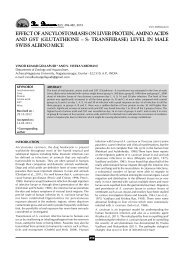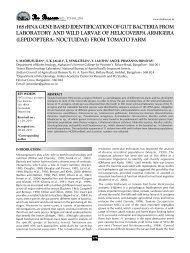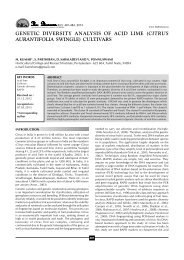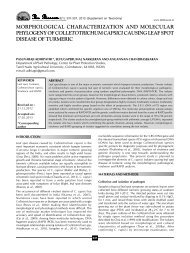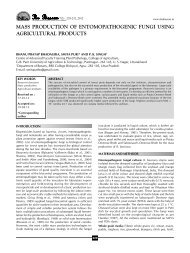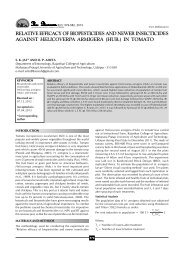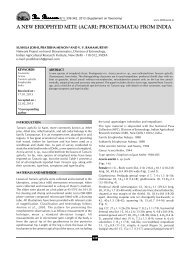earthworms in the himalaya and western ghats ... - THE BIOSCAN
earthworms in the himalaya and western ghats ... - THE BIOSCAN
earthworms in the himalaya and western ghats ... - THE BIOSCAN
Create successful ePaper yourself
Turn your PDF publications into a flip-book with our unique Google optimized e-Paper software.
MADHAB C. DASH AND K. G. SAXENA<br />
of <strong>the</strong> faunal wealth of <strong>the</strong> country are augmented by many<br />
researchers <strong>in</strong> o<strong>the</strong>r research <strong>and</strong> development <strong>in</strong>stitutions.<br />
N<strong>in</strong>e families of <strong>earthworms</strong> with 69 genera <strong>and</strong> 418 species<br />
have been reported from India. On <strong>the</strong> basis of available data,<br />
<strong>the</strong> Western Ghats <strong>and</strong> West Coastal Pla<strong>in</strong>s would st<strong>and</strong> out<br />
as <strong>the</strong> regions with <strong>the</strong> highest level of earthworm species<br />
richness followed by Eastern Himalayan Region, Sou<strong>the</strong>rn<br />
Plateau, Western Himalayan Region, Eastern Coastal Pla<strong>in</strong>s<br />
<strong>and</strong> Eastern Ghats, Gangetic Pla<strong>in</strong>s, Gujarat pla<strong>in</strong>s, Isl<strong>and</strong>s,<br />
Western dry Regions <strong>and</strong> transgangetc regions (Julka <strong>and</strong><br />
Mukherjee, 1984; Julka <strong>and</strong> Paliwal, 2005a <strong>and</strong> b; Dash <strong>and</strong><br />
Dash, 2008). The Western Ghats region is home to 53%<br />
species known from India compared to 26% <strong>and</strong> 12% <strong>in</strong> <strong>the</strong><br />
case of <strong>the</strong> Eastern Himalaya <strong>and</strong> <strong>the</strong> Western Himalaya,<br />
respectively. Drawida (38 species) is <strong>the</strong> most species rich<br />
genus followed by Megascolex (30 species) <strong>in</strong> <strong>the</strong> Western<br />
Ghats, Perionyx (33 species) followed by Drawida (14 species)<br />
<strong>in</strong> <strong>the</strong> Eastern Himalaya, <strong>and</strong> Perionyx <strong>and</strong> Amynthas (4<br />
species <strong>in</strong> each Genus) <strong>in</strong> <strong>the</strong> Western Himalaya. The Western<br />
Ghats harbour 193 native species compared to 85 <strong>in</strong> <strong>the</strong> Eastern<br />
Himalaya <strong>and</strong> 22 <strong>in</strong> <strong>the</strong> Western Himalaya, though <strong>the</strong> three<br />
regions do not differ much <strong>in</strong> terms of number exotic species<br />
(25-26). Among <strong>the</strong> native peregr<strong>in</strong>e species associated with<br />
agroecosystems, Octochaetona palniensis is conf<strong>in</strong>ed to <strong>the</strong><br />
Western Ghats <strong>and</strong> Lennogaster pusillus <strong>and</strong> Eutyphoeus spp.<br />
to <strong>the</strong> Western Himalaya. Among <strong>the</strong> exotics associated with<br />
agroecosystems, Drawida japonica was able to establish only<br />
<strong>in</strong> <strong>the</strong> Western Himalaya, while Dichogaster aff<strong>in</strong>is <strong>and</strong><br />
Pontoscolex corethrurus could establish <strong>in</strong> Eastern Himalaya<br />
<strong>and</strong> WesternGhats region but not <strong>in</strong> <strong>the</strong> Western Himalaya<br />
(Table 1).<br />
Earthworm communities <strong>and</strong> populations<br />
Studies <strong>in</strong> village l<strong>and</strong>scapes <strong>in</strong> central/<strong>western</strong> Himalaya<br />
(Bhadauria et al., 2000, S<strong>in</strong>ha et al., 2003) showed occurrence<br />
of three species <strong>in</strong> pasture soils compared to eight species <strong>in</strong><br />
o<strong>the</strong>r l<strong>and</strong>-uses, with Exotic Amynthas corticis be<strong>in</strong>g <strong>the</strong> most<br />
common species. Biological <strong>in</strong>vasion was observed <strong>in</strong> both<br />
early <strong>and</strong> late successional stages.<br />
Bhadauria <strong>and</strong> Ramakrishnan (2005) found three native<br />
species, viz., Tonoscolex horai, Drawida assamensis <strong>and</strong><br />
Perionyx sp. <strong>in</strong> <strong>the</strong> primary forest <strong>in</strong> north-east India.<br />
Conversion of primary forest for slashes <strong>and</strong> burn agriculture<br />
resulted <strong>in</strong> <strong>the</strong> loss of two native species <strong>and</strong> colonization of<br />
<strong>the</strong> disturbed area by ano<strong>the</strong>r native species viz., Nelloscolex<br />
strigosus <strong>and</strong> exotic Amynthas corticis. Although richness of<br />
native species <strong>in</strong>creased <strong>and</strong> <strong>the</strong> native species were able to<br />
coexist with <strong>the</strong> exotic species dur<strong>in</strong>g secondary succession<br />
after ab<strong>and</strong>onment of cultivation, complete restoration of native<br />
earthworm species assemblage did not occur. A similar trend<br />
was observed <strong>in</strong> central/<strong>western</strong> Himalayan region, though<br />
<strong>the</strong>re were differences <strong>in</strong> species found <strong>in</strong> <strong>the</strong> <strong>western</strong> <strong>and</strong><br />
eastern Himalaya (Bhadauria et al., 2012).<br />
Chaudhuri et al. (2008) found that conversion of primary<br />
forests to rubber plantations <strong>in</strong> Tripura led to dom<strong>in</strong>ance of<br />
<strong>the</strong> exotic-endogeic Pontoscolex corethrurus as well as a<br />
change <strong>in</strong> <strong>the</strong> functional status of this species, from endogeic<br />
<strong>in</strong> <strong>the</strong> primary forests to endo-anecic <strong>and</strong> endo-epigeic <strong>in</strong><br />
plantations. In general <strong>the</strong> change <strong>in</strong> l<strong>and</strong> use pattern or loss<br />
2<br />
of primary forest followed establishment of some exotic species<br />
<strong>and</strong> also replacement of some natives by o<strong>the</strong>r native species.<br />
Epigeic <strong>and</strong> anecic species, such as Dichogaster bolaui,<br />
Drawida willsi, Perionyx excavatus, Perionyx sansibaricus,<br />
Ramiella sp. <strong>and</strong> Lampito mauritii are widely distributed <strong>and</strong><br />
valued for <strong>the</strong>ir use <strong>in</strong> vermitechnology <strong>in</strong> Western <strong>and</strong> Eastern<br />
Table 1: Native peregr<strong>in</strong>e <strong>and</strong> exotic earthworm species associated<br />
with agroecosystems <strong>in</strong> <strong>the</strong> Himalaya <strong>and</strong> <strong>the</strong> Western Ghats region<br />
of India (based on Julka <strong>and</strong> Paliwal, 2005a &b <strong>and</strong> personal<br />
communication with Julka; A, absent; P, present)<br />
Native peregr<strong>in</strong>e Western Eastern Western<br />
species Himalaya Himalaya Ghats<br />
Lampito mauritii A P P<br />
Perionyx excavatus P P P<br />
Perionyx sansibaricus P A P<br />
Octochaetona beatrix<br />
Octochaetona surensis<br />
P A P<br />
Octochaetona palniensis A A P<br />
Lennogaster pusillus P A A<br />
Ramiella bishambari P A P<br />
Eytyphoeus <strong>in</strong>commodus P A A<br />
Eutyphoeus michaelseni P A A<br />
Eytophoeus waltoni P A A<br />
Drawida willsi A A A<br />
Drawida calebi A A A<br />
Drawida nepalensis P P A<br />
Thatonia gracilis<br />
Exotic species<br />
P A A<br />
Dichogaster aff<strong>in</strong>is A P P<br />
Dichogaster bolaui P P P<br />
Amynthas alex<strong>and</strong>ri P P P<br />
Amynthas corticis P P P<br />
Amynthas morrisi P P P<br />
Metaphire houlleti P P P<br />
Metaphire posthuma P P P<br />
Polypheiritima eleongata A P P<br />
Drawida japonica P A A<br />
Pontoscolex corethrurus A P P<br />
Ocnerodrilus occidentalis P A P<br />
Allobophora parva P P P<br />
Aporrectodea cal. trapezoiedes P P P<br />
Aporrectodearosea rosearosea P P P<br />
Eisenia fetida P P P<br />
Octolasion tyrtaeum<br />
Endemic genus/species<br />
P P P<br />
Curgiona A A P<br />
Kotegeharia A A P<br />
Mallehulla A A P<br />
Priodochaeta A A P<br />
Karmiella A A P<br />
Troyia A A P<br />
Comarodrilus A A P<br />
Chaetocotoides A A P<br />
Parryodrilus A A P<br />
Dashiella A A P<br />
Moniligaster A A P<br />
Celeriella A A P<br />
Lampito A A P<br />
Travoscolides A A P<br />
Wahoscolex A A P<br />
Tonoscolex A P A<br />
Kanchuria A P A<br />
Perionyx (4 species) P A A<br />
Eutyphoeus (2 species) P A A<br />
Plutellus (1 species) P A A



